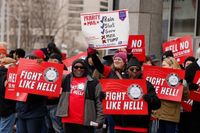On September 22, 2025, the streets of Turin, Italy, erupted with the energy of a union-organized nationwide strike. Pro-Palestinian protesters, joined by workers from across the country, marched under a banner that read, "Let's Block Everything." The demonstration was part of a wave of global protests that have swept through nearly every major world capital since October 2023, all aiming to challenge Israel's ongoing actions in Gaza and the unwavering support Western governments have shown for the Israeli state. Yet, as the dust settles on these mass mobilizations, a critical question lingers: What real leverage do working people have when governments remain unmoved by public outcry?
According to Middle East Eye, despite countless rallies, direct actions, and even international court findings, Western governments have maintained what can only be described as unconditional support for Israel. For two years, activists have pulled every lever of power available to them—marches, flotillas, policy papers, and more—only to see their governments make largely symbolic gestures in response to mounting pressure from below. The bombs, bullets, and profits continue to flow, and the slaughter of Palestinians has not been halted, even under the current ceasefire.
The heart of the issue, as articulated by Palestinian trade unions early in the conflict, is the need for workers worldwide to use their collective power. Their call was clear and urgent: halt the flow of weapons to Israel, refuse to build or transport arms, pressure governments to stop military trade, and take action against companies complicit in the siege of Gaza. In Belgium, workers answered by refusing to handle Israeli cargo, while ports around the globe temporarily blocked shipments of Western arms. Yet, these actions were exceptions rather than the rule. The broader labor movement, weakened by decades of neoliberal restructuring and political caution, largely limited itself to motions of solidarity and public letters, rather than the disruptive collective action that could force a true reckoning.
This pattern is not unique to the Palestine solidarity movement. In the United States, a parallel struggle is unfolding within the ranks of the National Association of Letter Carriers (NALC). From May 2023 to March 2025, the union’s members found themselves at a crossroads, negotiating a contract with the United States Postal Service (USPS) that offered a meager 1.3% wage increase and a raft of pro-management policies. As reported by Rob Darakjian of NALC Branch 2902 in Los Angeles, a reform caucus called Build a Fighting NALC (BFN) emerged to organize the first "Vote No" campaign in decades, bringing hundreds of rank-and-file letter carriers into the debate. More letter carriers voted down the tentative agreement than had participated in the previous contract vote, a sign of growing frustration and desire for change.
Yet, the outcome was sobering. As Darakjian explains, "the matter then proceeded to an arbitration process wherein unelected representatives from the union, USPS management, and a federally appointed 'neutral' arbiter decided on all contractual issues. Unsurprisingly, this undemocratic procedure produced the same tentative agreement that over 60,000 letter carriers had rejected, which was then imposed on our union." The episode highlighted a structural weakness at the heart of American labor: since 1955, federal workers—including the 640,000 people employed by the USPS—have been legally prohibited from striking.
BFN is now waging a campaign to change that, officially launching their Right to Strike Campaign on October 12th, 2025, with representatives from more than 20 NALC branches in attendance. Their goal is to push resolutions through local branches and ultimately propose a national fight for the right to strike at the 2026 NALC National Convention. The stakes are high. As Darakjian notes, "the need for the right to strike is more than just a fundamental right that all workers should have, but one even more critical than before as a defensive weapon." With the Trump administration threatening mass layoffs, government shutdowns, and the privatization of the USPS, the right to strike could prove essential in defending not only wages and benefits, but the very existence of a public postal service that guarantees mail delivery six days a week to every corner of the country.
These struggles—one unfolding on the docks of Casablanca and Genoa, the other in the post offices of Los Angeles and beyond—are united by a common thread. Both reveal the limitations of symbolic protest and the urgent need for collective action that can disrupt the machinery of profit and power. In Morocco, dockworkers in Casablanca refused to handle cargo suspected of containing components for F-35 fighter jets bound for Israel, despite intense political repression and the regime’s normalization with Israel. Their strike, combined with mass mobilizations in Casablanca and Tangier, successfully shut down ports and stopped ships. In Italy, dockworkers in Genoa, buoyed by mass protests, refused to load Israel-bound vessels, leading to two successful general strikes that even brought the traditionally cautious Italian General Confederation of Labour (CGIL) into the fray.
These victories, while limited and hard-won, point to the kind of radical tactics that may be necessary to force governments and corporations to choose between their geopolitical alliances and the stability of their own societies. As Middle East Eye observes, "workers have the collective ability to shut down entire economies, and to force our governments into choosing between their geopolitical alliances and stability at home. Social movements can support that work—and must urgently do so." The call is not merely for solidarity, but for transformation: rebuilding unions, democratizing workplaces, and asserting collective power over how labor and its fruits are used.
Yet, obstacles remain. The labor movement’s leadership, both in the U.S. and abroad, has often been slow to embrace mass action, preferring legal battles and incremental reforms over confrontation. As Darakjian puts it, "the primary way our current union leaders have responded has been to rely on the drawn out legal battles to parry the blows of the Trump administration, which hasn’t worked and won’t work." The specter of the Gilded Age—when workers had no legal recourse and faced violence for organizing—looms large as anti-labor forces seek to roll back hard-won rights.
For those fighting for Palestinian liberation, and for American postal workers defending their livelihoods, the lesson is clear: the power to change the world lies not in appeals to conscience or legal argument, but in the ability to disrupt business as usual. The intertwined struggles for justice abroad and dignity at home demand more than demonstrations or opinion pieces. They require strikes, mass mobilization, and the courage to challenge the status quo, even when the odds seem insurmountable.
As the banners in Turin declared, sometimes the only way forward is to block everything. The solidarity of workers—across borders, industries, and causes—may well be the most powerful weapon left in the fight for a more just and humane world.




